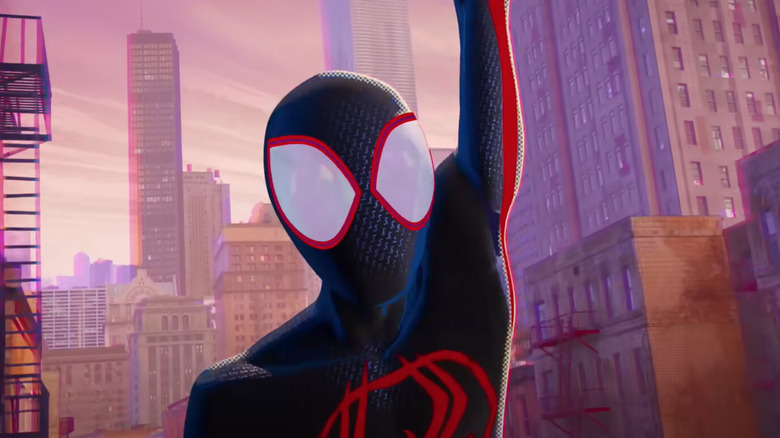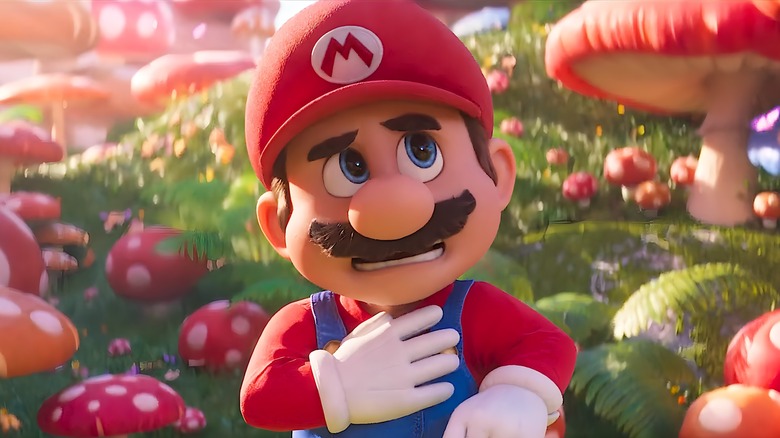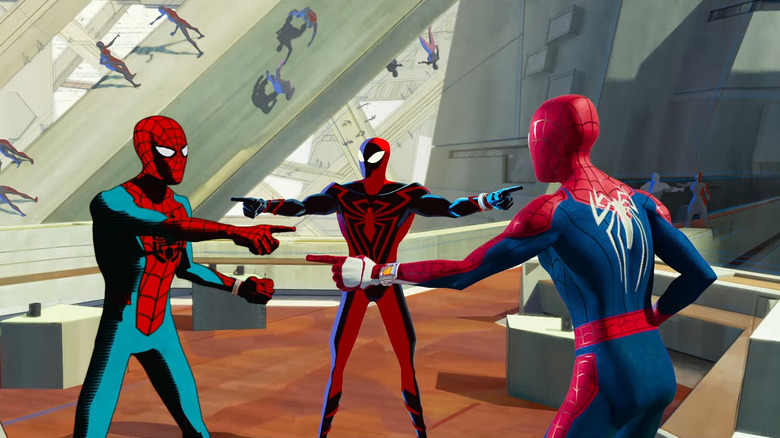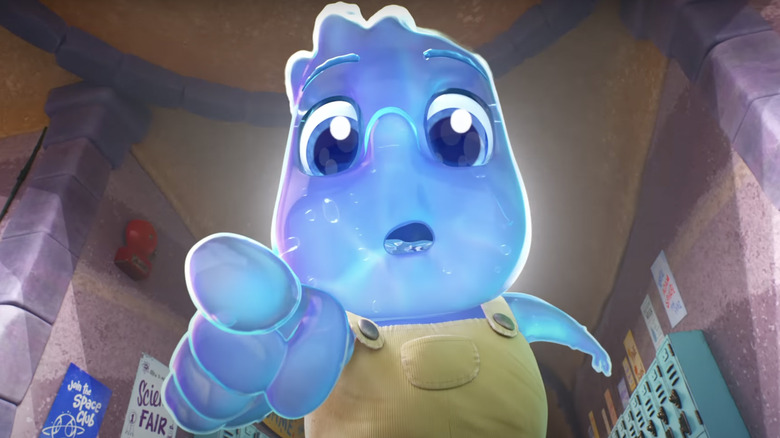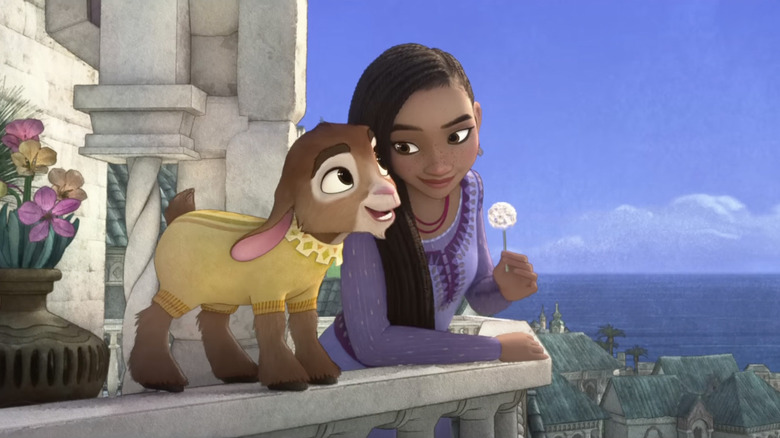Why Spider-Verse And Mario's Soaring Success Leaves Disney Animation In The Dust
It's a good time to be making movies.
The COVID-19 pandemic brought the film industry to a screeching halt, forcing theatres to shutter their doors as studios shuffled their theatrical slates. With the future of the theatrical model uncertain and studios itching to gain income quickly, potential blockbusters like "Soul" and "The Tomorrow War," which were initially slated for theatrical release, debuted on streaming.
It's now 2023 and the box office is slowly approaching pre-pandemic levels, largely in part due to studios and theatres deciding to work together. However, while films like "Top Gun: Maverick" and "Avatar: The Way of Water" brought audiences back to cinemas, its animated juggernauts like "The Super Mario Bros. Movie" and "Spider-Man: Across the Spider-Verse" which are compelling audiences to stick with the theatrical experience. The success of "Mario" and "Spider-Verse" can't solely be attributed to the fact they're IP. Both films, alongside their contemporaries, are doing something different.
Since theatres returned to capacity, Disney and its subsidiary Pixar's animated footprint has been microscopic when compared to rival studios, with Illumination and Sony Pictures Animation making strides at the box office and in the culture. The House of Mouse's animation division is going through a crisis. In 2019, Disney boasted 3 billion dollar-grossing animated flicks: "The Lion King," "Frozen II," and "Toy Story 4." Since then, no animated flick from the studio has managed to gross over $250 million, with the company debuting two unprecedented bombs with "Strange World" and "Lightyear."
What happened? While others are innovating, Disney has found itself running in place, failing to adapt on several fronts. Through a series of managerial missteps and uninspired decisions, Disney Animation has quietly handed its throne over to the players who were once playing catch-up.
Super Mario is the simple family-friendly adventure that millions wanted
When it comes to box office supremacy, it's Illumination that's at the top. With its crowd-pleasing stories and eye-popping visuals, the Universal-backed studio has managed to create three inoffensive billion-dollar franchises with "Despicable Me," "Sing," and "The Secret Life of Pets." While critics might label their films as safe, they're known quantities for families and children who want to be whisked away for 100 minutes or less.
With "The Super Mario Bros. Movie," they've delivered their biggest hit to date. Nintendo and its roster of characters have defined the video game medium, with characters like Mario and Luigi holding the same universality worldwide as a bottle of Coca-Cola or McDonald's golden arches. The animated picture, which debuted in early April with little competition at the multiplex, has grossed over $1.3 billion and has racked up nearly $100 million from Premium Video on Demand.
Why is "Mario" so successful (particularly when the 2023 film is compared to its divisive 1993 live-action predecessor)? It's simple. In keeping with Illumination's mantra of creating crowd-pleasing films, "Mario Bros." doesn't alienate. It capitalizes on its IP by treating it with reverence and respect. It doesn't go beyond its means and tries its best to create a piece of mass-market cinema that isn't overly complex, which allows it to be easily translated. Nearly 60% of the "Mario" gross is thanks to international markets, where the film was dubbed with local talent to match audience expectations. Unlike Disney's contemporary films, which primarily deal with Western-centric trials and tribulations, the appeal of "Super Mario" was wholly universal — audiences across the globe knew they were getting a simple, family-friendly comedy with the right amount of heart the moment they walked into cinemas.
Spider-Verse, meanwhile, innovates at every turn
If "Mario" is a testament to the power of IP and simplicity, then "Spider-Man: Across the Spider-Verse" is the opposite, an exposé on how IP can serve as a gateway to expand upon new and bold ideas. In the case of "Spider-Verse," it's the franchise's ability to chart a new path with its inventive animation, bleeding traditional hand-drawn looks with contemporary CG, creating a fluid, immersive visual language. "Into the Spider-Verse," which debuted in 2018, quickly became the blueprint for contemporary animation, with films like the upcoming "Teenage Mutant Ninja Turtles: Mutant Mayhem" taking cues from it. And the film's 2023 sequel has truly penetrated pop culture on another level, with many dubbing it as one of the best animated films of all time.
"Across the Spider-Verse" taps into both superhero and multiverse tropes with grace, capitalizing on audience expectations with its fair share of cameos and easter eggs. But it's the film's visuals that set it apart, proving that audiences are ready to digest animation styles that don't just replicate reality. "Spider-Verse" swings for the fences by playing with a variety of contrasting images and designs to create something that truly has to be witnessed on the biggest screen for possible. As superhero films lose their general hold over audiences, "Spider-Verse" stands out from the crowd because its "it factor" isn't the multiverse, but rather, its liberal use of several different animation techniques.
For Disney, this should be a wake-up call that their animation style is getting stale — audiences are ready for more visual risks.
Disney needs to balance between magic and strategy
The light on Disney's kingdom seems to be dimming, at least on the animation front. Illumination and Sony Pictures Animation –and arguably, DreamWorks Animation — are filling in for the once mighty behemoth, delivering hits that hold actual staying power. What's gone wrong for Disney? It's important to recognize that the slump is because of two things: (1) a lack of innovation and (2) business blunders that have robbed the company of its prestige. After diminishing returns with "Meet the Robinsons" and a failed return to hand-drawn animation with "The Princess and the Frog," Walt Disney Animation Studios found itself in a slump, while sister company Pixar was soaring to new heights. Their luck changed with 2013's billion-dollar grossing "Frozen," a film that playfully toyed with the studio's reputation for creating princess-centric films. With "Frozen," true love wasn't conventional heteronormative love, but the power of sisterhood, a subversion that proved Disney was moving beyond traditional, boxed-in themes, like Pixar.
Since that striking turn a decade ago, WDAS (and Pixar) have found themselves in a corner with one core theme: generational trauma. "Frozen II," "Turning Red," and "Encanto," among others, have focused on the sins of the past manifesting in the present. Repetitive narratives and themes are fine if there is visual diversity, but WDAS has largely followed in the footsteps of Pixar, trying its darndest to create 3D computer-animated films that emphasize realism. If "Spider-Verse" has proven anything, it's that audiences can value adventurous forms of animation that aren't wholly uniform. Pixar and WDAS were once the face of taking risks by focusing on realism, genre-bending narratives, and diverse characters. Today, that isn't enough.
Disney has no one to blame but itself
"Toy Story 4" and "Frozen II" grossed over $1 billion in 2019. If "Toy Story 5" and "Frozen III" were to hit cinemas this calendar year, it's difficult to imagine them grossing over $800 million. IP matters, right? Not when it's diluted. In a bid to boost Disney+'s clout during the COVID-19 pandemic, Disney sent several of Walt Disney Studio Animation Studios and Pixar films to the service, robbing instant classics like "Soul" and "Turning Red" of profitable theatrical runs. Even "Raya and the Last Dragon," a film that should have been widely celebrated for its diverse story and roster of characters, was sent to Disney+'s Premier Access to squeeze up a quick profit. The result? Families across the globe realizing that their $7.99 a month subscription to Disney+ was a far better bet than buying tickets for the company's latest animated effort.
"Lightyear," what should have been a surefire hit, dropped the ball with middling critical reception and a gross of $218 million. The kooky sci-fi epic "Strange World," which boasted out-of-this-world visual aesthetics, couldn't take flight with a $69 million cume — one of the company's biggest financial failures. And "Elemental," the closest thing to a riff on "Inside Out," debuted to shy of $29 million – just $2 million less than the third-weekend gross of "Spider-Verse."
Disney knows they fumbled the bag by sending their films to Disney+, with Pixar chief Pete Docter telling Variety that the company trained audiences to expect films on the service. It also doesn't help that their films cost way too much. In pursuing realism, Disney's bank accounts are being drained, with "Elemental" and "Lightyear" boasting $200 million price tags. "Spider-Verse" and "Mario," meanwhile? $100 million, shortening the amount of success they truly need.
Disney will persevere
The success of "Super Mario Bros" and "Spider-Verse" should scare Disney. The once-mighty powerhouse needs to figure out a way to bring audiences back to cinemas because, frankly, the Disney magic is dissipating as each day goes by. Luckily, "Mario" and "Spider-Verse" provide the necessary steps for Disney to rebound.
Disney should continue to focus on cost-cutting, bringing down the budgets for its animated flicks. If both "Mario" and "Spider-Verse" can become record-breaking and genre-defining films with small budgets, Disney should be able to do the same. Another way to save money? Actually release films in theatres. Recent flounders like "Lightyear" and "Elemental" should not signal that the theatrical model is dead. Treat Disney+ as the company's archive, not its saving grace. Allow future and recent projects like "Elemental," to premiere on PVOD after their time in the cinema is done. Give it months before sending the film to Disney+, where it can live forever. This is what Disney does with its Marvel films and, most recently, "Avatar: The Way of Water."
But no managerial switch-ups and financial cutbacks can change audience perception. Audiences want something new. If "Mario" was the power of IP and general breeziness coming to life, then "Spider-Verse" is proof that risks can be taken. Disney, pick your fighter. Instead of regurgitating IP, like with "Lightyear," allow Pixar to bring the world of "Avatar" or "Star Wars" to animation. Or switch up your tried-and-tested 3D animation style for something that pops, forcing audiences to witness the latest visual marvel on the biggest screen possible.
With "Wish," Disney seems to be doing just that, blending 3D animation with watercolors to create a look that no one else is doing. Now, will Disney succeed with this upcoming "risk?" That's up to the audience members.
